End Date: Saturday, March 29, 2025

Grabado en la Ciudad de Oaxaca por Colectivo Subterráneos. Fotografía de Gustavo García, 2024.
**Recepción de inauguración: sábado, 7 de septiembre, 2024, de 2-4 pm. Los co-curadores darán una plática seguida por una breve presentación por el Colectivo Subterráneos. Se ofrecerá interpretación de inglés/español; también se ofrecerá bebidas y comida ligera.**
¡Oaxaca Ingobernable!: Estética, política y arte desde abajo, explora representaciones subversivas de poder, movilización y resistencia de comunidades indígenas y afros oaxaqueños en México y Estados Unidos a través de instalaciones de grabados en el Centro Hibben y el Museo Maxwell de Antropología de la Universidad de Nuevo México.
En el Atrio del Centro Hibben, hay una serie de obras del Colectivo Subterráneos y al lado, en el Museo Maxwell, hay una instalación del Colectivo Subterráneos y Pavel Acevedo. Juntos, estos artistas exploran críticamente los impactos históricos y contemporáneos del colonialismo y el capitalismo en las comunidades marginadas de Oaxaca. Sus obras, en su grandez representan la vida real de comunidades indígenas que luchan por conservar sus conocimientos, tierras, idiomas, y prácticas colectivas frente al indigenismo, racismo antinegro, la xenofobia y la deshumanización. A través de una historia compartida de política rebelde, solidaridad comunitaria y tácticas visualmente audaces, estos artistas encarnan el espíritu de ingobernabilidad y se esfuerzan por incitar un cambio social positivo en Oaxaca y más allá.
Colectivo Subterráneos es un grupo multigeneracional de artistas oaxaqueños, compuesto principalmente por jóvenes, que hacen grabados y murales para iluminar temas sociales. El colectivo comenzó formalmente en 2021 con solo seis miembros y desde entonces ha crecido a más de treinta miembros. Mantienen un espacio de usos múltiples en el centro de Oaxaca donde hacen, exhiben y venden arte y dirigen una escuela de arte gratuita llamada Escuela de Arte para el Pueblo. Sus tradiciones artísticas y políticas han sido moldeadas por movimientos sociales en Oaxaca y más allá. Inspirados por artistas de izquierda internacionalistas, su nombre Subterráneos los alinea con comunidades de clase trabajadora, explotadas y oprimidas que ocupan espacios de abajo, fuera de la política de arriba y las jerarquías sociales.
El objetivo principal del colectivo es crear arte que sea políticamente representativo y accesible para las comunidades locales. Al crear arte público que no está autorizado en las calles como su lienzo principal, Subterráneos recupera espacios que lentamente se está apoderando el capital global y se los devuelve a las comunidades de Oaxaca. A través de sus talleres crean más espacios para que miembros de la comunidad aprendan la técnica del grabado y otras prácticas artísticas que les permitan compartir sus historias y también vivir económicamente del arte.
El artista Pavel Acevedo nació en Oaxaca, México y actualmente vive en Riverside, California. Sus experiencias en las protestas oaxaqueñas, incluido el levantamiento popular de 2006 en la ciudad de Oaxaca y los movimientos en California, dan forma al foco de su trabajo creativo. Utiliza la impresión en linóleo y el muralismo para abordar las luchas profundas que él y muchos oaxaqueños enfrentan en torno a la migración, las fronteras y los estados nacionales. Su práctica de grabado colaborativo fomenta la creación de significado colectivo. Acevedo se basa en la narración zapoteca y las experiencias de los inmigrantes oaxaqueños contemporáneos para combinar el mundo natural con visiones rebeldes y afirmativas de la vida del ser oaxaqueño.
Juntos, estos artistas ofrecen representaciones visuales de pueblos indígenas y afro-oaxaqueñas, particularmente las luchas por preservar tradiciones, culturas, prácticas colectivas y resistencias contra la opresión. A través de su trabajo, continúan promulgando una política ingobernable que ha estado presente en las comunidades indígenas y afro-oaxaqueñas durante muchos siglos.
Esta exhibición cuenta con el generoso apoyo del Departamento de Estudios Chicanos y Chicanas, El Centro de la Raza, el Centro de Estudios Regionales y el Centro Alfonso Ortiz de Estudios Interculturales.
Taller de Grabado: Acompáñanos el 30 de septiembre a 5 de octubre para participar en talleres de grabado con Pavel Acevedo. más información de los talleres saldrá muy pronto.
Contacto: Si tienen preguntas o quieren más información, comuníquese con el curador de programas públicos de Maxwell, Julián Antonio Carrillo (jac123@unm.edu) y el co-curador de la exposición Gustavo García (garciagustavo1@unm.edu).
Para descargar el Comunidado de Prensa bilingüe (en español e inglés) haga clic aquí
End Date: Saturday, March 29, 2025
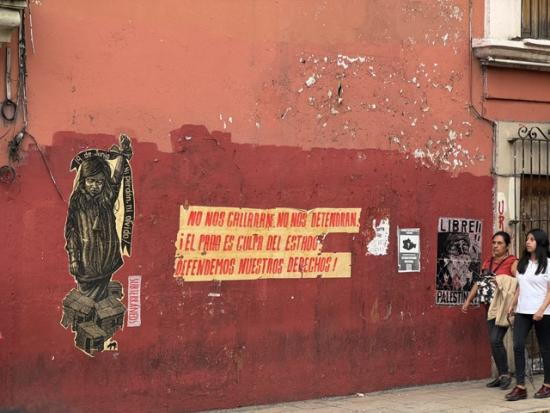
Street art in Oaxaca City, Oaxaca featuring prints (left and center) by Colectivo Subterráneos. Photograph by Gustavo García, 2024.
Oaxaca Ingobernable: Aesthetics, Politics, and Art from Below, explores subversive representations of embodied resistance by Indigenous and Black Oaxacan communities in Mexico and the United States through collaborative artmaking practices and largescale relief prints, on view in the Hibben Center and Maxwell Museum of Anthropology at the University of New Mexico.
On display in the Hibben Center is an array of work by Colectivo Subterráneos, and next door at the Maxwel Museum of Anthropology is a site-specific installation by Colectivo Subterráneos and Pavel Acevedo. These artists critically interrogate historical and contemporary impacts of colonialism and capitalism on marginalized Oaxacan communities. Their striking, often larger than life works depict how these communities—of which they are part—struggle to retain Indigenous knowledges, lands, languages, and collective practices in the face of indigenismo, antiblackness, xenophobia, and dehumanization. Through a shared history of rebellious politics, communal solidarity, and visually bold tactics, these artists embody the spirit of ungovernability, and strive to incite positive social change in Oaxaca and beyond.
Colectivo Subterráneos (Underground Collective) is a multi-generational group of Oaxacan artists, primarily composed of young people, who create relief prints and murals to illuminate social issues. The collective formally started in 2021 with just six members and has since grown to over thirty members. They maintain a multipurpose space in the center of Oaxaca where they make, show, and sell art and run a free arts school called Escuela de Arte para el Pueblo (Art School for the People). Their artistic and political traditions have been shaped by social movements in Oaxaca and beyond. Inspired by internationalist leftist artists, their name purposefully aligns them with working class, exploited, and oppressed communities who occupy spaces below the upper-class and outside of top-down politics and social hierarchies.
The collective's main goal is to create art that is politically representative of and accessible to local communities. By creating unsanctioned public art and activating the streets as their primary canvas, Subterráneos reclaim spaces slowly being seized by external global capital and return these spaces to the community. Through their workshops, they create more spaces for community members where they can learn artistic practices that not only allow them to share their stories but also make a living from producing art.
Artist Pavel Acevedo was born in Oaxaca, Mexico and currently resides in Riverside, California. His experiences in Oaxacan protests, including the 2006 popular uprising in Oaxaca City and movements in California, shape the focus of his creative work. He uses linoleum printing and muralism to engage with the deep and often overwhelming tensions he and countless other Oaxacans experience around migration, borders, and nation states. His practice of collaborative printmaking encourages collective meaning making. Acevedo draws on Zapotec storytelling and contemporary Oaxacan migrant experiences to blend the (super)natural world with rebellious and life-affirming visions of Oaxacan being.
Together, these artists offer visually compelling stories of Indigenous and Black Oaxacan communities and their struggles across time and place to remember tradition, culture, collective practices and resistance to systemic oppression and erasure. Through their work, they continue to enact an ungovernable politic that has been present in Indigenous and Afro-Oaxacan communities for centuries. This exhibit is generously supported by the Department of Chicana/o Studies, El Centro de la Raza, Center for Regional Studies, the Alfonso Ortiz Center for Intercultural Studies, and the Latin American & Iberian Institute.
Relief Printing Workshops: Please join us September 30 to October 5, 2024 for hands-on linoleum printing workshops with Pavel Acevedo. Stay tuned for more information.
Contact: For questions or more information, please contact the Maxwell Museum’s Curator of Public Programs Julián Antonio Carrillo (jac123@unm.edu) and exhibition co--curator Gustavo Garcia (garciagustavo1@unm.edu).
Bilingual (in Spanish and English) Exhibition Press Kit is available here.
End Date: Saturday, December 7, 2024
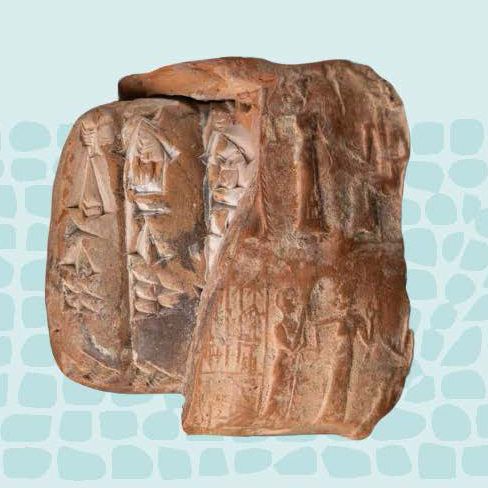
Administrative tablet in clay envelope with seal impressions. King Shulgi of Ur, 2094-2047 BCE. MMA 67.34.1
In 1967, Museum Director Frank C. Hibben donated a small collection of inscribed clay tablets to the UNM Anthropology Museum (now the Maxwell Museum of Anthropology). These tablets, dating between 4100 and 1600 years ago, come from Mesopotamia in modern Southwest Asia, home to the world’s first cities, states, and writing systems.
Since their decipherment in the 1850s, tablets inscribed in cuneiform (wedge-shaped) script have provided insights into the economic, social, and religious lives of ancient Mesopotamians. They have also circulated around the world—as a result of colonial era archaeological expeditions, looting, and rampant site destruction fueled by terrorism, war, and economic desperation.
This exhibition highlights the eight cuneiform tablets in the Maxwell Museum collections and our attempts to uncover their journey to Albuquerque. It explores what such artifacts, once removed from their archaeological context, can – and cannot – teach us about the Mesopotamian past. It also explores the past and present legacies of the removal and destruction of cultural heritage and current efforts toward the restoration and restitution of archaeological heritage in the Middle East and far beyond.
End Date: Saturday, July 27, 2024
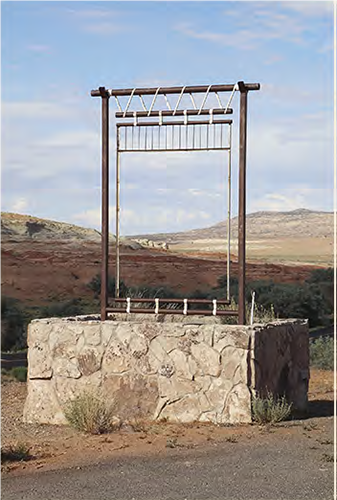
Since the advent of photography, Indigenous people have been subjects, romanticized by both photographers and viewers as “authentic,” “primitive,” and members of a “vanishing race.” This photographic history is inseparably linked to the histories of museums and science, in which curators, artists, anthropologists, and sociologists took Indigenous people’s belongings and stories, captured their images and recorded their voices and fundamentally attempted to strip away their sovereign sense of identity, community, and belonging.
Within the last two to three decades, Indigenous photographers have finally become recognized as active, generative participants in the telling of their own stories and Diné photographer Rapheal Begay is taking a leading role in this movement.
The Maxwell Museum of Anthropology and Axle Contemporary are proud to announce a partnership with photographer Rapheal Begay (Diné) and independent curator Lillia McEnaney. ALL REZ: Kéyah, Hooghan, K’é, Iiná / Land, Home, Kinship, Life is a traveling, site-specific, experimental photography exhibition and museological project.
While the Maxwell will feature an installation of Begay’s photography documenting his perspectives of these cultural themes within the landscape, the traveling portion of ALL REZ will take Begay’s photographs back to his home community in the Axle Contemporary mobile artspace.
Comprised of a retrofitted 1970 aluminum panel delivery truck, the interior of the Axle gallery will be transformed into a welcoming space for reflection and conversation with the artist about his photographs and the cultural content held therein. As an exercise in creative place-making with the goal of fostering active storytelling, ALL REZ centers the voices and experiences of Diné community members, offering a reciprocal process of exhibition-making.
The Maxwell invites you to a kickoff celebration with Axle Contemporary at the Museum on June 1 from 4 pm to 7 pm.
From June 6 through 29, the Axle truck will tour Diné Bikéyah (the Navajo Nation) stopping at a variety of community gathering spaces in Crownpoint, Gallup, and Shiprock New Mexico; Chinle and Window Rock, Arizona; and Monument Valley, Utah. You can keep in touch with the project team while they are on the road this summer through real-time updates in our gallery and on the project website: www.allrez.net.
To support the project, please visit our campaign at ImpactUNM.
Download presskit here.
Exhibition Book List is available here.
End Date: Wednesday, January 31, 2024
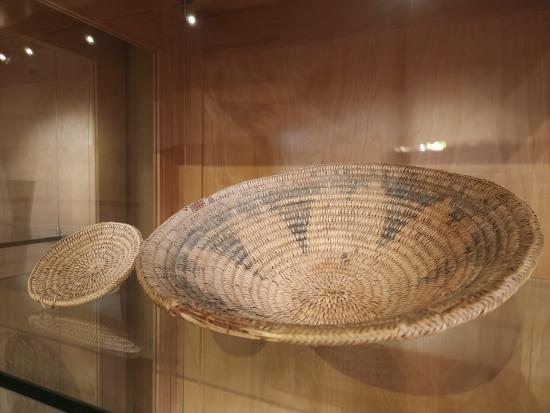
In July 2022, a group of distinguished Pueblo artists and knowledge holders came to the Maxwell Museum to view a selection of Pueblo baskets from the museum’s collections. This group was composed of Louie García (Tiwa/Piro Pueblo), Christopher Lewis (Zuni), Jilli M. Oyenque (Ohkay Owingeh), Paul Tosa (Jemez Pueblo), Madeline Tosa (Jemez Pueblo), and Brian Vallo (Acoma Pueblo). Accompanying them was anthropologist and UNM alumnus, Dr. Bruce Bernstein.
The group generously shared knowledge about the varied techniques, uses, and meanings embedded within these baskets, and together, with museum staff and guest co-curator Dr. Bernstein, they agreed to co-curate an exhibition presenting these rarely seen objects to the public. The result is "We Were Basket Makers Before We Were Pueblo People: Pueblo Baskets in Context" which is housed in the Alfonso Ortiz Center Gathering Space of the Museum.
Like the fibers that make up these intricate baskets themselves, the voices of the co-curators are independent powerful strands of understanding that come together to offer us a greater appreciation of the artwork and its signficance. Come see the exhibit which will be on display through January 2024, in conjuction with our other temporary exhibit on baskets, "Conversing with the Land: Native North American Baskets of the Maxwell Museum Collections."
This exhibit is in part sponsored by the Alfonso Ortiz Center for Intercultural Studies.
End Date: Wednesday, January 31, 2024
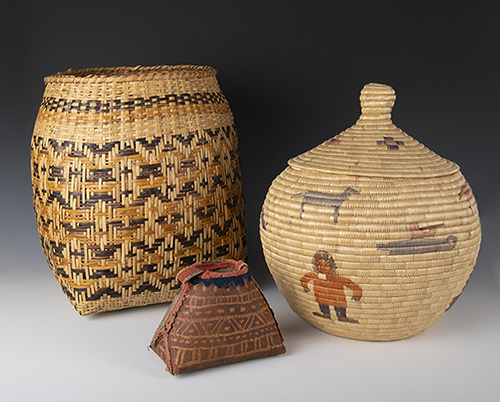
Find the labels for all of the baskets in the exhibition here.
End Date: Thursday, March 16, 2023
Visit our temporary exhibit in honor of Black History Month which will feature two new and original artpieces by folk artist Karen Collins, Founder & CEO of the African American Miniature Museum. In particular, the exhibit will feature a diorama of Blackdom, NM and one of archaeologist/rancher George McJunkin.
Also, don't forget to pencil in the date for a special lecture on Blackdom, NM, by historian Dr. Timothy E. Nelson on February 23, 2023, titled: "Blackdom, New Mexico: The Significance of the Afro-Frontier" free and open to the public.
Check back soon for more information and photos!
End Date: Tuesday, February 28, 2023
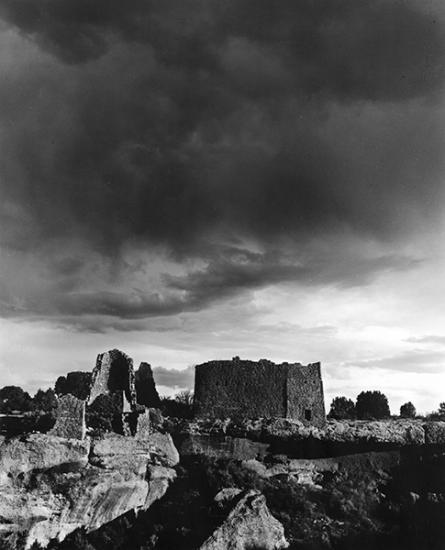
In early May 2022, the Maxwell presented a new exhibition in our Center Gallery featuring photographs from our archive. The exhibition, titled In the Places of the Spirits: Photos of David Grant Noblem, was curated by Maxwell Archivist Diane Tyink and features a selection of stunning photographs from this new acquisition. The Maxwell is honored that this is one of only two exhibits in which Noble's work has been shown as a whole, as most of his photographs are dispersed in different galleries and/or publications. David Grant Noble is a photographer and writer whose focus is the history and archaeology of the American Southwest, though he has worked around the nation and around the globe.
On David Grant Noble
David Grant Noble was born and raised in Massachusetts, attended Yale University, served in the army in Vietnam, and was for many years on the staff of the School for Advanced Research. While in the army in the 1960s, Noble photographed Vietnam's Central Highlands. These were his first photographs and were recently published in his memoir, “Saigon to Pleiku: A Counterintelligence Agent in Vietnam’s Central Highlands, 1962-1963.” In 1970 and 1971, he photographed Mohawk ironworkers in New York City - some of those photographs featured in the Smithsonian Institution National Museum of the American Indian 2002 exhibition Booming Out: Mohawk Ironworkers Build New York, co-curated by the Maxwell's own Curator of Exhibitions, Devorah Romanek. Noble's work includes a series on Ojibwe wild rice harvesters in Wisconsin and Minnesota, followed by his work in the Southwest.
He became interested in photographing the Southwest’s ancient cultural landscapes in 1972-1974, when he was the photographer on the School for Advanced Research’s excavations at Arroyo Hondo Pueblo, near Santa Fe. This job soon led to his writing and illustrating his archaeological guide, “Ancient Ruins and Rock Art of the Southwest,” which, in turn, led to “In the Places of the Spirits.” He has authored or edited a dozen books on the deep history of the American Southwest.
Noble’s photographs are in many collections, including the Smithsonian’s National Museum of the American Indian, Yale University’s Beinecke Library, The New York State Museum, and the Heard Museum, in addition to the Maxwell Museum of Anthropology. Examples of his photography can be seen at his website. He lives in Santa Fe and is presently writing an archaeological murder mystery set in the Southwest.
This exhibit is sponsored by UNM's Alfonso Ortiz Center for Intercultural Studies.
End Date: Saturday, February 18, 2023
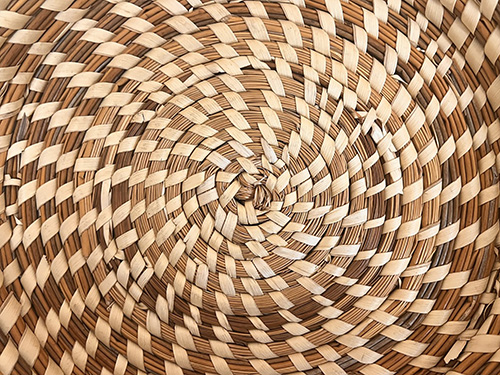
Visit our temporary exhibit in honor of Black History Month which features Gullah/Geechee baskets from the Museum's collection, one of the country's oldest and most beautiful handicrafts with African roots. This addition is also intended to complement our two current temporary exhibits "We Were Basket Makers Before We Were Pueblo People" & "Conversing with the Land" & "We Were Basket Makers Before We Were Pueblo People."
Click here to see all of the Gullah/Geechee baskets in the Maxwell Museum collections.
End Date: Wednesday, August 31, 2022
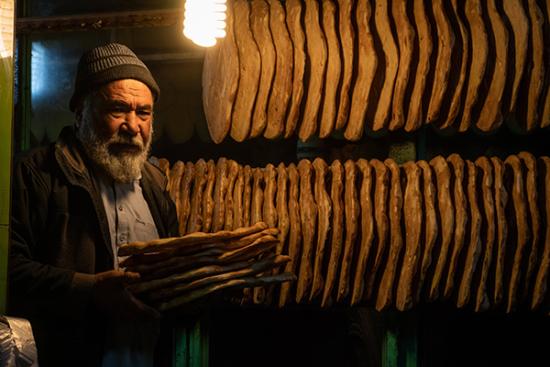
Assadullah in Kabul bakery 2018 (Photograph by Ivan Flores, for article "In Kabul, Naan Endures, by Ruchi Kumar)
The Maxwell Museum's Current Issues in Anthropology exhibitions are timely displays that affirm out commitment to share information and create a forum to address current events and issues affecting our region and our world.
End Date: Saturday, August 27, 2022
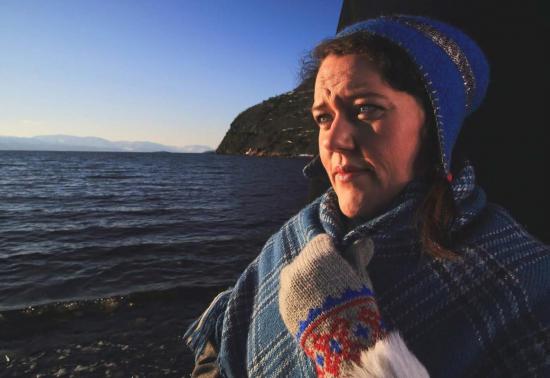
In early May 2022, the Maxwell inaugurated Sámi Dreams, an exhibition loaned by Norway House of Minneapolis, Minnesota. This exhibition, about the Indigenous people of Northern Europe, features the photographs of Randall Hyman and first-hand testimony of Sámi people living across northern Scandinavia. The exhibition contains oral histories, and addresses issues pertaining to Indigenous rights, Scandinavian culture, and Arctic climate change. This exhibit will remain at the Maxwell until Saturday, August 27, 2022.
In a separate section of the North gallery, the Maxwell is also presenting Sámi objects from its own collection and highlighting the theme of climate change, an issue the museum has addressed through many exhibitions of the last few years (i.e., Archaeology on Ice and Drowned River, among others), and which we intend to continue addressing in future exhibitions.
On Randall Hyman
Randall Hyman has traveled the globe on magazine assignments for over four decades covering natural history, science, and cultural topics from Northern Europe to South America to Asia to Africa. His photo essays and articles have appeared in a range of magazines including Smithsonian, National Geographic Traveler, Discover, American History, The Atlantic, Foreign Affairs, Huffington Post, Science, Wildlife Conservation, National Wildlife, British Heritage and various National Geographic books.
As a 2013 Fulbright Scholar in Norway and guest of the Norwegian Polar Institute, Mr. Hyman covered field science, resource development, and climate change in the Arctic for a number of organizations and publications. In 2015, he was the distinguished Josephine Patterson Albright Fellow of the Alicia Patterson Foundation, expanding on his coverage of Arctic climate change. In 2018 he photographed and produced this exhibit about the Sami, northern Europe's only Indigenous people, which began touring North America in 2019. He continues to focus on Arctic topics and lecture on polar climate change across the United States and Europe.
(See his magazine work including a showcase of the Sámi exhibit)
This exhibit is sponsored by UNM's Alfonso Ortiz Center for Intercultural Studies.
End Date: Saturday, May 28, 2022
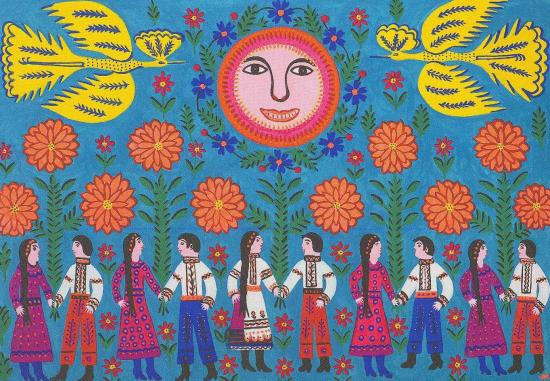
Maria Prymachenko, Our Army, Our Protectors (1978). Invading Russian forces destroyed a museum in Ivankiv, a city northwest of the capital Kyiv, that was home to dozens of works by the Ukrainian folk artist Maria Prymachenko, on February 27, 2022.
The Maxwell Museum's Current Issues in Anthropology exhibitions are timely displays that affirm out commitment to share information and create a forum to address current events and issues affecting our region and our world.
Our display near the store of the Maxwell Museum addresses recent events in Ukraine and seeks to share knowledge on Native American and Eastern European historical ties, provoke thought and encourage action.
A Ukrainian Scarf in Native America
Kokum / Masani Scarf (or “Sani”)/ Khutska
These scarves, known by several names, reveal deep connections between Ukraine and Native North America. The origin of this type of scarf, worn by Indigenous people throughout North America, is Eastern European and is most associated with Ukraine, where it is called a “khutska,” “hutska,” or “babushka.” In the 19th century they were produced in Eastern Europe. Today they are typically made in Russia or China and are sold online as either Ukrainian or Native American fashion.
The yellow scarf was purchased at the Kewa gas station on the Kewa (Santo Domingo) Pueblo, as such scarves can often be found in general goods stores in Indian Country. The pink scarf was made in Albuquerque and, as seen for sale online, was labelled a “Navajo Grandma Scarf.” “Masani” means grandmother in Diné Bizaad, or the Navajo language.
The brightly colored floral scarf, known variably in Native America as the “Kokum,” or among the Diné (Navajo) as the “Masani (grandmother) Scarf,” has its origins in Ukraine, where it is known as the “khutska,” “hutska,” or “babushka.”
The scarf made its way to North America with Ukrainian and Russian immigrants who came to Canada and the United States in large numbers in the 1900s, and with the import of Eastern European textiles in the same period. The headscarf, and a larger version sometimes worn as a shawl, were items of trade between Ukrainian-Canadian farmers and members of the Cree Nation in Alberta...
Read the full exhibit text and see its accompanying images in this PDF based on the exhibition.
End Date: Sunday, May 1, 2022
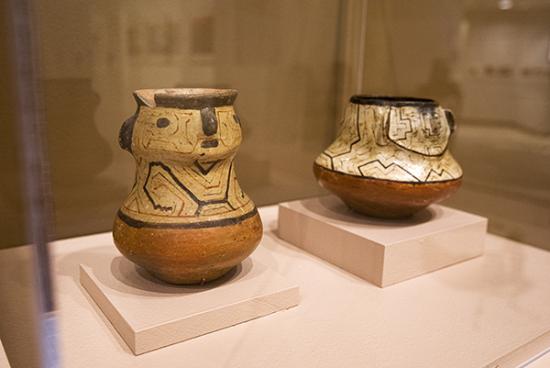
Shipibo effigy jars (chomo). (MMA 2007.39.1 L, MMA 80.46.3 R)
The Maxwell Museum holds a small collection of objects and reproductions from the Amazon. From Headwaters to Mouth features objects spanning 2000 years from communities on opposite ends of the River: the island of Marajó at the mouth of the Amazon, and along the Ucayali River in Peru, a major tributary that feeds into the Amazon at its head. Shipibo artists are renowned for their intricately decorated pottery and textiles, ornamented with kené, designs that exist beyond the realm of humans and emerge from the skin of the primordial anaconda. Contemporary and historic photographs of Shipibo artists, landscapes and communities enrich the exhibition, which also feature a distinct Marajoaran object directly connected to the lost National Museum of Brazil.
End Date: Saturday, April 23, 2022
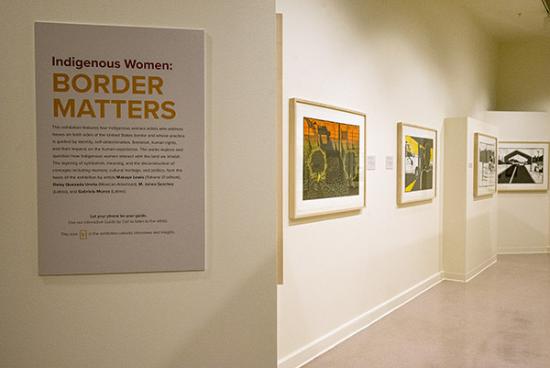
End Date: Sunday, March 20, 2022
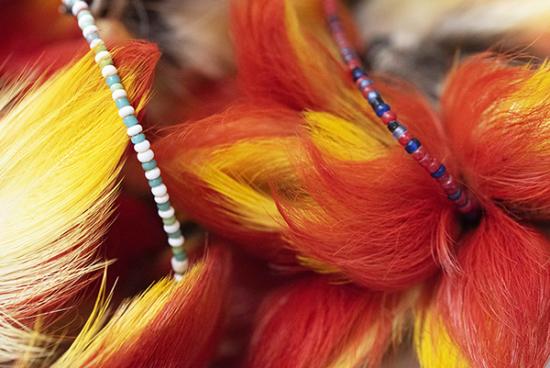
The fire destroyed the last records of Indigenous languages no longer spoken, and irreplaceable examples of material culture from now colonized Indigenous groups. Years of government neglect and underfunding led to dangerous conditions at the museum and culminated in its destruction. Some view the government’s handling of the National Museum as analogous to their treatment of Brazil’s indigenous nations. There are hundreds of distinct Indigenous groups currently living in traditional ways in the Brazilian Amazon. However, they are under increasing threat from violence and encroaching industrial activity. Immediately after taking office in January of 2019,Brazilian president Jair Bolsonaro began radically stripping the Indigenous nations and their lands of their rights and protections. Deforestation of the Amazon rainforest quadrupled in the first month of Bolsonaro’s presidency alone.
The loss of the Amazon rainforest is not only catastrophic for the Indigenous people who make it their home, but for all Brazilians in relation to their history and culture. Further, it impacts all of us around the globe. The Amazon rainforest plays a vital role in regulating global climate. It stores huge amounts of harmful carbon dioxide and is responsible for creating 20% of the planet's oxygen, earning it the name "the lungs of the planet." The Indigenous nations of Brazil have intimate knowledge of this delicate ecosystem, making them not only stewards of the Amazon rainforest, but of the planet at large.
This exhibition is a love letter to what was lost in the fire that destroyed the National Museum of Brazil, and a cautionary tale of the current political situation in Brazil, which has compounded the losses suffered from the fire. It is a letter to the Indigenous nations of Brazil, to all Brazilians, and to all of us who rely on the Amazon, the “lungs of the planet.”
End Date: Saturday, September 25, 2021
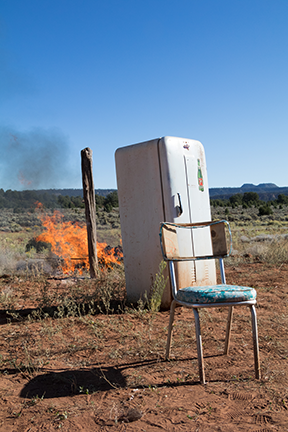
Thirst-Quenchin’ (Navajo, NM), 2017 by Rapheal Begay
“Exploring the past, creating the present, and curating the future.”
The photography of Diné photographer Rapheal Begay presents an account of the Navajo Nation—without ever directly portraying any people—by focusing on the land and the material and visual culture of the people. By bringing these photographs into our museum and combining them with a small selection of related material culture from our collection, the Navajo Nation and New Mexico, the Maxwell Museum offers an opportunity to engage with a contemporary portrait of Diné people, picturing the land and culture viewed through the camera lens and words of Raphael Begay.
A Vernacular Response is the documentation of land and environment with respect to symbolism, perspective, and imagination reflective of the Diné way of life. An ongoing theme within the series is the acknowledgement and celebration of Indigenous innovation and future forward imaging. One can discern the role of creativity within Navajo art and life as a strategy for survival. The Navajo cultural teaching of hozho expresses the intellectual concept of order, the emotional state of happiness, the biological condition of health and well-being, and the aesthetic dimensions of balance, harmony, and beauty. Therefore, concept and content become synonymous with one another as both elements become interchangeable within the frame of the image.
“With the sky above and the earth below, I find myself connected to the land and to my surroundings. I believe the recollection of self through connection to memory creates a bridge between life and art. Through practicing the art of photography I am able to create my own path and, create community. At the end of the day, I strive to acknowledge and embrace each singular moment; A Vernacular Response.” Rapheal Begay
Many anthropology museums have their origins in the salvage anthropology and vanishing race theories of the late 19th and early 20th centuries, when anthropologists and museum curators collected the material culture of Indigenous Peoples thinking they would soon literally or culturally disappear, due to the impact of colonization. The Maxwell Museum, like so many other anthropology museums, contends with the legacy of such collecting practices, and works to facilitate more accurate contemporary portraits of those represented in its collections, with some notable portion of the collection being comprised of Diné (Navajo) material culture.
End Date: Tuesday, December 31, 2019
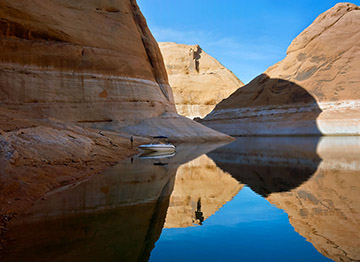
Detail of Still Water in Side Canyon, lake Powell, 2012
In the early 1960s, photographer Eliot Porter photographed Glen Canyon, a stunning landscape slated to be submerged under the waters of the Colorado River with the construction of the Glen Canyon dam. The Sierra Club published a book of the images in mid-1963, called The Place No One Knew, in an attempt to halt the proposed dam. The effort failed, and Lake Powell was created, becoming a bustling recreation area atop the majestic canyonlands.
In their most recent project together, Mark Klett, Byron Wolfe and Rebecca Solnit engaged with Porter’s published work to make a vital statement about climate change. Years of exploration of Lake Powell, making pictures, studying Porter, and learning about the history and future of Glen Canyon produced a body of work in which Solnit’s sparse and effective text is interwoven with Klett and Wolfe’s impressionistic images.
Drowned River: The Death and Rebirth of Glen Canyon on the Colorado, documents both the devastation of the dam project, as well as the unanticipated resilience of the Colorado River.
End Date: Tuesday, December 31, 2019
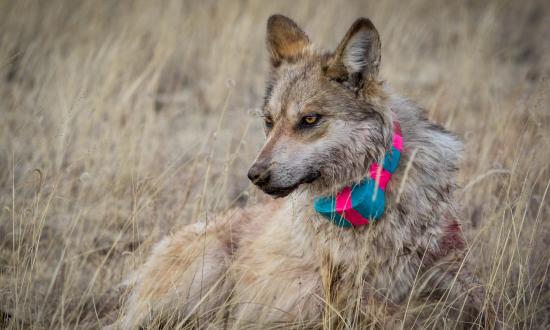
A Mexican Wolf that has just been collared for purposes of tracking, Arizona, February 2018. Image: Jenna Miller/Cronkite News
Perhaps no other animal in North America has been as controversial as the gray wolf, which once numbered in the millions on this continent. Massive reductions of wolf populations began with the arrival of European settlers. Today, wolves continue to be central in debates about the American ecosystem. Preservationists and environmentalists usually argue for their protection and renewal, while ranchers and their advocates often argue for reduction if not their elimination. The exhibition investigates the biology and history of the Mexican Wolf, focusing on the human/wolf relationship.
End Date: Monday, August 5, 2019
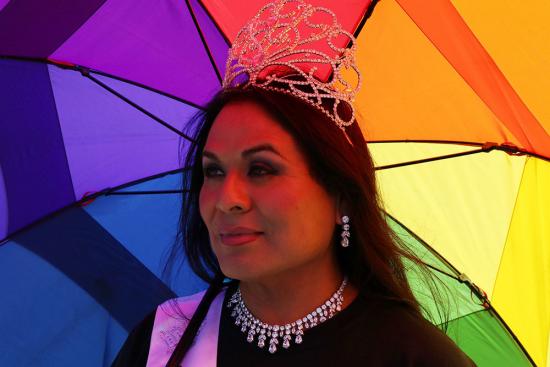
Queen of Diné Pride, Navajo Nation, 2018. Rapheal Begay
The Stonewall Uprising, the 50th Anniversary, on exhibition June 25 - August 5, 2019
This exhibition, created by the non-profit Stonewall fifty-fifty, is a commemoration of the 50th anniversary of the Stonewall Uprising, a galvanizing event in the struggle for LGBT+ civil rights. Included are a recounting of the Uprising, and of LGBTQ+ communities in New Mexico, on the Navajo Nation, and during the Harlem Rennaisance.
End Date: Saturday, July 27, 2019

Servando Gonzales (left) and fellow musicians, ca. 1919. Private Gonzales of Tijeras played the violin in his division, the 19th Infantry, Company E. Photo Courtesy of the New Mexico State Records Center and Archives.
New Mexico achieved Statehood just two years before the Great War, World War I, broke out in Europe in 1914. The global conflict ended with the signing of the armistice on November 11, 1918.
This year, with the 100th anniversary of the signing of the armistice, the New Mexico History Museum opened a permanent exhibition entitled The First World War, guest curated by Devorah Romanek, Curator of Exhibits at the Maxwell, featuring the stories, images and letters home from New Mexicans who served. The Maxwell Museum hosts an abbreviated version of this exhibition.
End Date: Tuesday, March 19, 2019
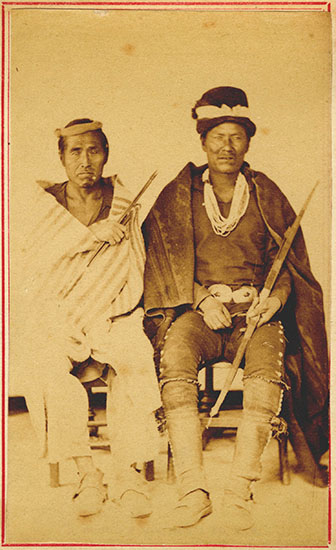
Unidentified Diné Man and Manuelito,
New Mexico Territory, ca. 1867
By Nicholas Brown & Son
Diné, meaning “The People,” is how the Navajo refer to themselves. The Diné comprise the largest Indigenous nation in North America. Diné Bikéyah, also known as The Navajo Nation, stretches across portions of Utah, Arizona, and New Mexico; at more than 27,000 square miles, it is larger than 10 of the U.S. States.
In 1598 the founding of the Spanish colony of New Mexico changed the lives of the Diné forever, marking the beginning of the often-violent changes brought by settler colonialism. In 1848 the U.S. Army arrived in New Mexico territory, and in 1864 the U.S. government forcibly removed the Diné from their homeland to an impoverished tract of land known as the Bosque Redondo, in eastern New Mexico. This exhibition observes the 150th anniversary of the signing of the Navajo Peace Treaty, which took place on June 1, 1868, after the Diné insisted on being allowed to return home. The Diné are the only Native Nation to successfully use a treaty to retain their homeland.
End Date: Saturday, November 17, 2018
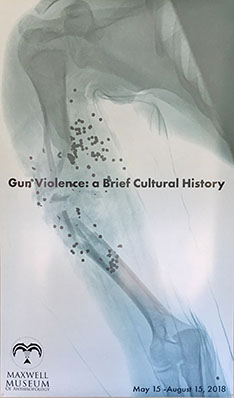
An X-ray of an shotgun wound to the upper arm. Image: Case courtesy of Dr. David Cuete, Radiopaedia.org, rID24457
Mass shootings involving guns have become a fact of American culture. While mass murders happened throughout recorded history, changing civilian gun technology has made the murders more deadly.
However, most gun deaths are not mass shootings. For example, in 2015 gun suicides killed 22,000 Americans, homicides killed 13,000 people, and mass shootings killed 46.
Museums have played a role in the romanticizing of guns, which began with the earliest display of guns in European “Cabinets of Curiosity.” For example, the 17th century Ashmolean collection in Oxford contained numerous firearms, including a musket of the Elizabethan period inlaid with mother-of-pearl and engraved with the heads of Roman emperors. The British Leverian collection in Westminster had early 18th century Turkish guns, and Napoleon III had a Prussian needle gun in his Cabinet of Curiosities. In the late 1800s, Augustus Henry Lane Fox Pitt-Rivers, founder of Oxford’s Pitt Rivers Museum, assembled a large collection meant to trace the evolution of firearms. In the 19th century as museums collected the spoils of colonization, the collection and display of guns and others weapons increased. Military museums, built around armaments amassed for citizen militias and the national military, began housing and displaying enormous collections of guns.
American museums, particularly those that portrayed Western expansion, created exhibitions that glamorized firearms, with persistent themes including the “Kentucky” or “Pennsylvania” Rifle (long rifles), Colt revolvers, and armed outlaws who carried these firearms. Such exhibitions celebrated a gun-slinging American frontier, based in part on historical events, in part on popular legends, and, in part on outright fiction. Museums have not been the only ones romanticizing guns, but their role in this process is undeniable.
Dave Phillips and Devorah Romanek, 2018
End Date: Saturday, April 28, 2018
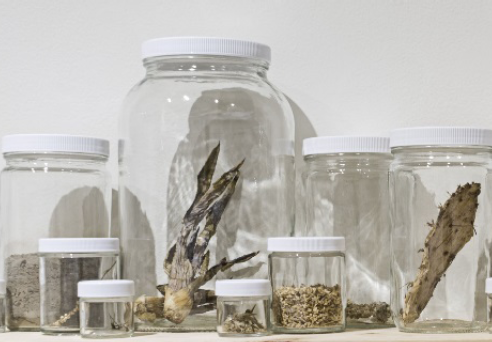
Samples from DesertArt LAB Pueblo Colorado reclamation project.
Ecologies of Resistance illustrates the artistic process of the DesertArt LAB collaborative’s site-specific ecological installation in the high desert of southern Colorado, through the use of artifacts, archival materials, and botanical samples. The collaborative is transforming a plot of blighted land into a thriving dryland ecosystem that also serves as an edible native landscape. Informed by social sculpture, the collaborative believes artists have the ability to altruistically transform and shape their environments and society. Re-growing ecologies in community space allows for the revitalization of ecological practice and a reimagining of an indigenous dryland cosmology and aesthetic.
About DesertArt LAB:
April Bojorquez has worked in the museum field nationally/internationally as an educator, curator, and researcher. She is based in the San Francisco area and Southern Colorado. Bojorquez is fellow of the Smithsonian Institution’s Latino Museum Studies Program. She is a former faculty of American Ethnic Studies and assistant curator at the Marianna Kistler Beach Museum at Kansas State University.
Matt Garcia’s artistic practice investigates ecology, its relationship to knowledge systems and how media can connect communities to a reclaiming or re-imagining of lost epistemology. Garcia is an assistant professor of Art and Design at Dominican University of California. Garcia was formerly an assistant professor of Digital/Experimental Media in the Department of Art at Kansas State University. Garcia’s work has been presented nationally and internationally at venues such as: Ecole Nationale Supérieure des Beaux-Arts (Paris, France).
End Date: Saturday, March 31, 2018
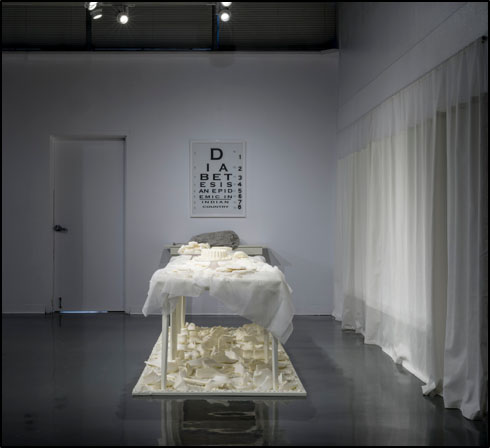
Last Supper exhibition still by C. Maxx Stevens
Last Supper by C.Maxx Stevens, Seminole/Mvskoke, is a conceptual installation pointing to the negative effect of contemporary diets, and the devastating effect of diabetes throughout native nations. Stevens’ builds a visual narrative based on private and public memories and experiences. The exhibition Last Supper creates a larger social awareness of the epidemic and its dilemma in all of the United States: one out of every six native people will develop diabetes or be affected by the disease. The mixed media installation includes Stevens’ family archives and testimony about the disease and its impact on traditional values and the drastic evolution of diet as well as economy.
C.Maxx Stevens is an Installation artist and Seminole/Mvskoke Nation from the Oklahoma Region. Her art is based on memories of family and culture expressed in three dimensional environments using materials, objects, and technology to build a visual narrative. She is currently an Assistant Professor of Art at the University of Colorado in Boulder, Colorado serving as the Foundation Arts Director in the Art and Art History Department. C.Maxx has been a recipient of many awards and honors such as 2014 Art Matters Grant in New York, New York, 2005 Eiteljorge Fellowship Award. She has exhibited at the Smithsonian American Indian Museum Heye Center in New York City, New York; C. N. Gorman Museum, University of California at Davis, Davis, California; Eiteljorge Museum of Indian Art, Indianapolis, Indiana; Museum of Arts and Crafts, New York, New York; Center for Contemporary Arts, Santa Fe, New Mexico; Institute of American Indian Arts Museum, Santa Fe, New Mexico; Gordon Snelgrove Gallery, University of Saskatchewan, Saskatoon, Saskatchewan, Canada; The Montana Museum of Art and Culture, Missoula, Montana; Boise Art Museum, Boise, Montana; and White Mountain Academy Gallery, Elliot Lake, Ontario, Canada to name a few.
Last Supper is presented in partnership with the IAIA Museum of Contemporary Native Arts and will be on display through March 31, 2018, a reception and gallery talk withC. Maxx Stevens will take place Friday, March 2, from 6 – 7:30 at the Maxwell Museum. The event is free and open to all.
End Date: Saturday, March 10, 2018
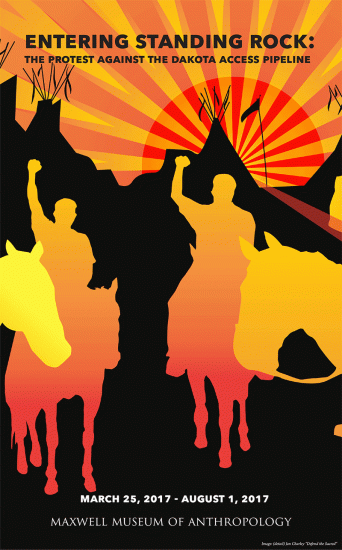
Image (detail) Jon Charley "Defend the Sacred"
Native Americans have been resisting colonial and American government impositions since the arrival of colonists in the Americas during the 15th century. Opposition includes events as diverse as the Pueblo Revolt of 1680 and the founding of the American Indian Movement (AIM) in 1968. The current protest at the Standing Rock Reservation in North Dakota against the Dakota Access Pipeline (NoDAPL) is utilizing new strategies, technologies, media, and allies.
The NoDAPL protest began in response to a proposal to build a 1,172 mile long pipeline crossing multiple states, communities, farms, fragile wildlife habitats, and tribal lands. The protest has involved members of more than 100 indigenous tribes as well as non-tribal citizens.
The exhibition features photographs, posters, film, music, news reporting and other works by artists, journalists and activists who have supported or participated and offers a glimpse into life at the camp and shows how artists and protestors use social media to spread the message of protest.
End Date: Saturday, March 3, 2018
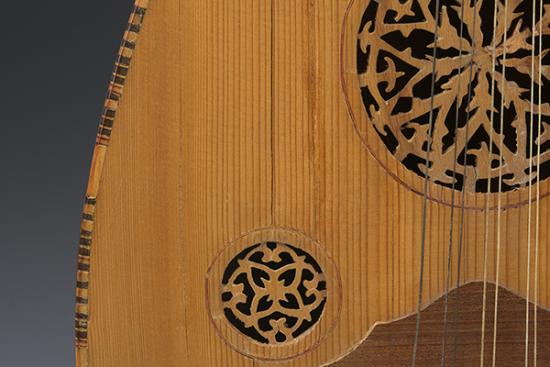
(detail) Woman's Oud, mid-20th century, Maxwell Museum of Anthropology Collection
The title of this small but important exhibition is taken from a common refrain chanted at recent protests happening around the country: “No Hate, No Fear, immigrants (or “refugees”) are welcome here!” The protests were a response to the executive ban of immigrants and refugees from Iraq, Syria, Iran, Libya, Somalia, Sudan and Yemen. The protests reflect both a long history of Americans resisting government decisions they find objectionable (starting with the Boston Tea Party of 1773), and the power of social media to unite groups with a common purpose.
In this exhibition, which features both musical instruments from the countries singled out in the original ban and coverage of the protests at airports against the ban, we encourage visitors to contemplate the implications of the ban, as it continues to be debated, litigated, and revised.
End Date: Saturday, March 3, 2018
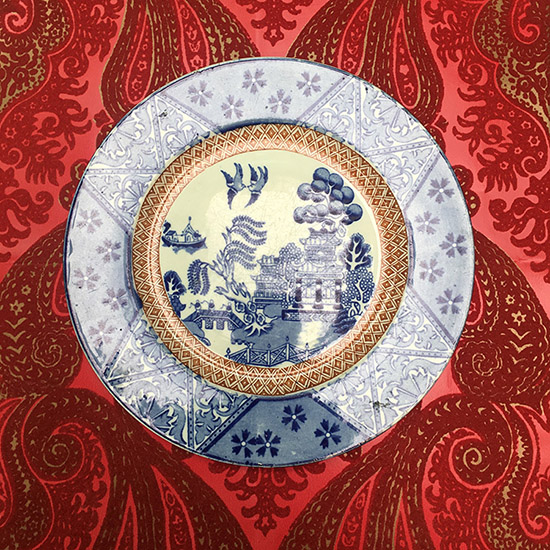
Many things we use every day, from coffee mugs to iPhones, come from China. The pattern began more than 2,000 years ago, when the Han dynasty promoted the "Silk Road" through central Asia, and the first porcelain objects arrived in Europe in 1338. For almost two centures afterwards porcelain was a rarity, owned mostly by kings and high nobles. Once Portuguese ships reached China in the early 1500s, it was suddenly possible to transport large quantities of Chinese ceramics directly to the West. In the early 1700s the Chinese reorganized their porcelain production to cater to Western demand. This exhibition highlights that history and its impact on cultural dynamics spanning hundreds of years and featuring dozens of ceramics from around the world in exploring this phenomenon.
End Date: Saturday, September 30, 2017
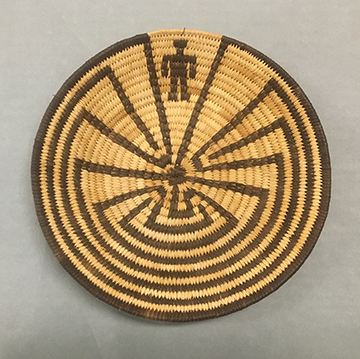
Tohono O’odham Man in the Maze basket, ca. First half of the 20th century, Maxwell Museum of Anthropology Collection
The cultural ramifications of national borders have become an increasingly important topic in anthropology, mirroring the global importance of the topic in general. Because New Mexico is on the U.S.-Mexico border, the politics of that border are deeply important to the state and its people. The recent presidential election also made the border and immigration controversial issues.
In light of recent events and the long and complicated history of the U.S.-Mexican border, La Frontera examines border and immigration policies and realities from an anthropological perspective through the use of images of the border, objects – personal and political – related to the border, and personal reflections from people and organizations who are most directly impacted by the border and immigration policy. We ask what the border means to different people, and what the border means to you.
La Frontera y Nuevo Mexico: The border and New Mexico is an anthropological investigation of the U.S. Mexican border in two parts, the first section currently on exhibition in the Maxwell is an introduction to the topic and the second section will be installed by January 31 in the Hibben Center, just south of the Maxwell. La Frontera is the latest in the Current Issues in Anthropology series of exhibitions. Presenting news media, historic documents, personal reflections and objects, the series presents thought provoking topics and requests feedback
End Date: Friday, June 16, 2017

China’s historical role in the global ceramics market is so pervasive that in English, “china” is a synonym for porcelain and similar wares. We invite you to examine more than 100 pieces of “china” created and used as China took shape, and became the civilization we know today. Supported by The Ortiz Center, New Mexico Humanities Council, Eason Eige, the Tang family, the Chan family and Mr. Ed Jeung.
End Date: Saturday, January 14, 2017
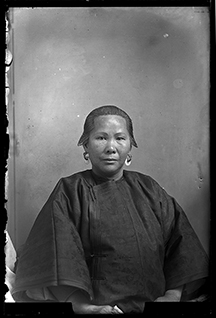
End Date: Wednesday, June 15, 2016
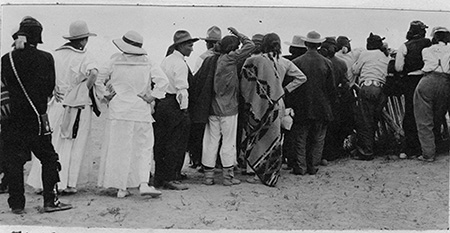
Photography occupies a unique position in the world of invention, with the photographic image held as both an expression of hard factual evidence and as subject to complex theoretical interpretation.
Evidence and Theory: Photographs from the Archive of the Maxwell Museum of Anthropology questions the fundamental interpretation of photographic imagery and the relationship between seeing and knowing truth. The exhibition explores this duality through a collection of historical images from the Maxwell Archive, many on display for the first time
End Date: Saturday, January 30, 2016
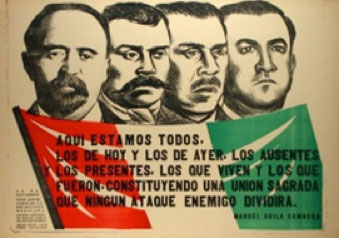
Anniversary of the Mexican Revolution Poster, 1942 (reproduction).
Courtesy of The University of New Mexico Center for Southwest Research
The Mexican Revolution was a multifaceted drama that involved various factions. Several issues instigated rebellion, but Francisco Madero's November 20, 1910 revolt against the Dictator Porfirio Díaz, has been designated as the official beginning of the Mexican Revolution. Narratives of the war evolved beyond the violent phase of the insurgency, and, over time, competing or counter narratives and understandings of the insurrection have continued to emerge.
The legacy of the Mexican Revolution is (re)defined and (re)constructed by what is remembered through various ongoing processes of memorialization, institutionalization, education, and celebration.
End Date: Saturday, January 30, 2016
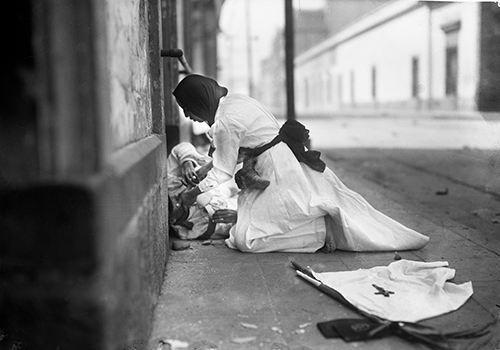
The Mexican Revolution began in 1910 with an uprising led by Francisco I. Madero against longtime dictator Porfirio Díaz. The Revolution is generally considered to have lasted until 1920, although the country continued to have sporadic outbreaks of warfare well into the 1920s. It gave birth to the Mexican Constitution of 1917.
A nascent generation of photographers documented the struggle. Sabino Osuna was among the photographers who appeared on the scene and was able to get close to the action. The images he produced cover primarily the early years of the Revolution, in particular the Decena Trágica. As nonpartisan observers, photographers covered the events and enjoyed the liberty of moving freely among the rival troops. They carried no weapons and posed no threat to the warring factions.
Fifty-six images selected for the exhibition come from the Osuna Collection of 427 glass negatives that are held in the University of California Riverside Libraries Special Collections & Archives. The Osuna collection is both historically important as well as visually impressive and coherent, presenting one person’s point of view. The exhibition of the photographs is augmented with historic and contemporary objects related to the Mexican Revolution.
Mexico at the Hour of Combat is supported by the Consulado de México en Albuquerque, UNM Chicana/Chicano Studies, Global Education Office, Latin American & Iberian Institute, the Ortiz Center for Intercultural Studies and Univision.
End Date: Sunday, October 4, 2015
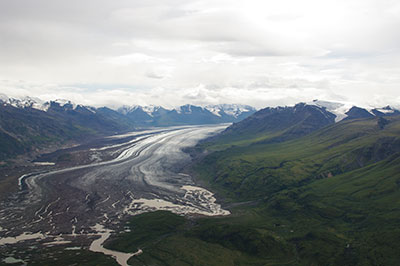
Ancient ice is melting throughout the world, and in the Arctic, annual average temperature has increased at almost twice the rate as that of the rest of the earth. Artifacts that have been frozen in ice for thousands of years are emerging. A team of researchers from the University of New Mexico led by James Dixon investigated ice patches in Alaska’s Wrangell-St. Elias National Park and Preserve. The results of the ten year project are the subject of a new exhibition at the Maxwell Museum of Anthropology.
Archaeology on Ice tells the story of the climate change in the Arctic through a unique collaboration between scientists, the Ahtna Heritage Foundation and tribal members. The exceptional preservation of the organic tools (wood, antler, bone, and leather) found at ice patches has enabled people to make direct links between today and the past. Many local people participated in the research to locate and preserve these rare artifacts. They have shared their knowledge about their customary and traditional use of the land and its resources. Artifacts on display include arrows, spear points, and birch bark baskets.
Four short educational videos present significant results of this research:
https://www.youtube.com/watch?v=MsZ1MRfQZAU
https://www.youtube.com/watch?v=N_0Atd9eePo
End Date: Sunday, May 3, 2015
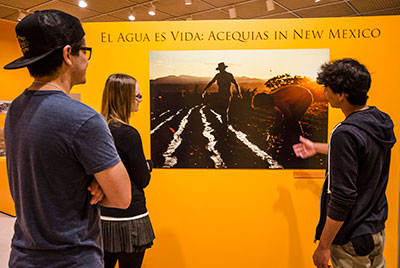
The northern New Mexican landscape as seen today was created by acequia irrigation and agriculture. Every colonial settlement that took root between 1600 and 1847 required the construction of ditches to channel water to grow crops and sustain livestock. By 1700, an estimated 60 acequias, or ditches, were operating in New Mexico, followed by more than 100 acequias over the next one hundred years, with at least 300 additional acequias built in the 1800s.
El Agua es Vida: Acequias in Northern New Mexico portrays the fundamental role acequias play in the environment and in community in Northern New Mexico, where water is a precious resource of increasing scarcity. The exhibition uses a groundbreaking multi-disciplinary study conducted by researchers at the University of New Mexico, New Mexico State University, New Mexico Tech and Sandia Labs. The study, funded by the National Science Foundation, investigates the importance of the acequia system of water delivery and management in generating, transforming and sustaining the landscape.
The water crisis of the 21st century is global. Many of the questions that concern acequia researchers have also been pursued by researchers working on similar systems in other parts of the world.
End Date: Saturday, February 21, 2015
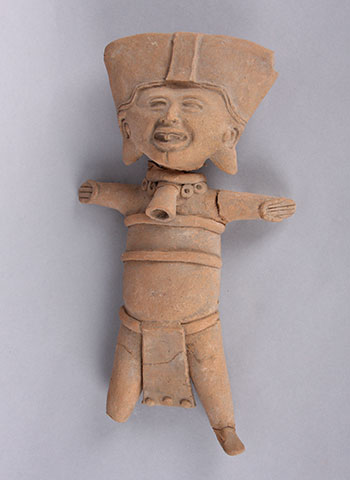
The Maxwell has collected pottery since its inception in 1932, primarily focusing on the U.S. Southwest. With the help of donors, the expansion of the pottery collection has become global, supporting efforts to think and talk about the wider world from an anthropological perspective. This exhibition displayed Chinese ceramic pieces, ranging from the Neolithic period (starting 10,000 B.C.) to contemporary times; contemporary pottery of sub-Saharan Africa; Remojadas figurines from the Gulf Coast of Mexico; and the local expression of the prehistoric Pueblo world - the Casas Grandes culture (between 1200 and 1450 C.E.) located in what is now Chihuahua Mexico.
End Date: Friday, November 7, 2014
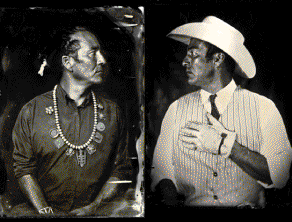
The exhibit displayed portraits by Diné artist/photographer Wilson taken using a vintage, large format camera and using the historic wet plate collodion process. The photographic process references a bygone era and the historic images that continue to contribute to society's collective understanding of Native American people.